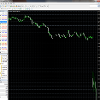- Accueil
- Communauté
- Traders Expérimentés
- At what position size would orders begin to have market impa...
Advertisement
Edit Your Comment
At what position size would orders begin to have market impact?
forex_trader_240856
Membre depuis Apr 08, 2015
posts 8
Membre depuis May 20, 2011
posts 694
Membre depuis Oct 02, 2014
posts 905
Membre depuis Oct 11, 2013
posts 769
Jul 14, 2015 at 03:16
Membre depuis Oct 11, 2013
posts 769
Ok, to move the Forex market takes a lot of money. 50 lots is a drop in the sea. I have traded as much as 9 standard lots and the broker wasnt able to execute the whole order at the same price, usually I would get different price entries, but that does not mean that I was moving the market, no way. The only ones that may be able to move the Forex market for a short period of time are the central banks.
Membre depuis Apr 04, 2010
posts 12
Jul 14, 2015 at 16:58
Membre depuis Apr 04, 2010
posts 12
A couple of hundred million on EUR/$ and even that might not work - its less about amount and more about given liquidity, how much would it take to get price out of value.
Basic lot size traded between banks is EUR5mio for divisibility. Then you get guys who specialise in block trades who can likely soak up multiple lots of 20-50 million. In the old days all you had to do was smack few guys to clear out the liquidity and create a bit of confusion after which you could move things fairly easily.
Present day you have multiple venues, many of them electronic and with electronics comes algos. An algo just wants to have the inside price so no matter what you do, the algo will always put up a price which complicates things.
Basic lot size traded between banks is EUR5mio for divisibility. Then you get guys who specialise in block trades who can likely soak up multiple lots of 20-50 million. In the old days all you had to do was smack few guys to clear out the liquidity and create a bit of confusion after which you could move things fairly easily.
Present day you have multiple venues, many of them electronic and with electronics comes algos. An algo just wants to have the inside price so no matter what you do, the algo will always put up a price which complicates things.
If you like it, buy it. If you don't sell it.

forex_trader_186239
Membre depuis Apr 15, 2014
posts 224
Jul 15, 2015 at 10:35
Membre depuis Apr 15, 2014
posts 224
Nobody really studied stability of FX market prices seriously, if it is chaotic as the modern nonlinear dynamics says, even a tiny amount is sufficient to move market. Just remember the "Butterfly Effect ".
You can learn about here: https://en.wikipedia.org/wiki/Butterfly_effect
You can learn about here: https://en.wikipedia.org/wiki/Butterfly_effect
Membre depuis Apr 04, 2010
posts 12
Jul 15, 2015 at 20:05
(édité Jul 15, 2015 at 20:14)
Membre depuis Apr 04, 2010
posts 12
Here is the thing. Once upon a time I was an Emerging Market bond broker and it took me two hours to put together a bond trade. 3 hours prior to that was price discovery and book building. And I am not talking a trade worth hundreds of millions, I think it was $10 million equivalent.
So how does anything remotely quantitative or algo relate to this? Hand on heart I can say that I have never spoken to a quant or algo guy that really and truly at his core understands markets.
Two hours on a $10mio EM bond trade is tradecraft. Very illiquid, wide spreads. Haggling endlessly on the phone first to find a bid, then the offer, then find out where the interest actually is, then close the gap, then get someone to cross the spread and do it all at a yield that everyone was happy with. Very mundane but this kind of thing is what markets and trades are built on and comes longer before Tech Analysis and Quant Trading.
Back to this algo thing. I remember back in 2000 one could sit at a desk for 10 hours and EUR/$ would move maybe 30 or 40 pips. Now we can do that at the London open. Once upon a time 100 pips moves were rare. Now they are a regular feature yet daily volumes in FX are constantly increasing. Surely this would make things a more stable rather than less stable?
Imagine a scenario
10 human market makers making EUR/$ with 5 pip spreads. They wont all have the same bids and offers so lets say when you look at the overlap the inside spread is 3 pips. Now, spread compensates a market maker for taking risk, so essentially if he has trading interest, this will be his inside price and the other side of the spread is a dummy cos its outside of the market and therefore wont trade.
All of this works really nicely until you start having more platforms than voice trading and Reuters dealing. Along come various electronic venues paying incentives to access volume. With this come quants with various theories about this and that. I never made it past high school maths but I can market make 4 currencies at a time, have no idea what my position is or what my average rate is but muddle through and turn a profit. Don't know how I do it, and I certainly don't know how to code it so a computer can do the same thing.
ECNs came with changes some of which included HFT and trading algos. One of their biggest "problems" is quote stuffing or fighting to be the inside price and the other issue is no two way interest or interest beyond winning a trade on the way in and out. The first effect is that instead of a 3 pip spread, the spread can be thinned to next to zero (as we have seen with EUR/$ spreads over the past 20 odd years). This however comes with a problem. At a zero spread a market maker can't cover his costs of providing liquidity and taking risk so he will go do something else (such as focusing on block trading at prices outside of the ECN platforms and leave the micro lot stuff to the ECNs).
The end result is a lot of machines fighting over price and "confusion". I say confusion cos I can sit at a Bloomberg terminal, watch the pricing (largely provided by banks) and read the tape reasonably well. If I do the same with a broker feed its a different story.
I have attached screen grabs of EUR/$ from 3 different brokers for moves in EUR/$ on 5th June 2015 just after (if I recall correctly) NFP
One shows a very nice gap lower and the other 2 have a spike up (and a stop hunt or whatever other conspiracy theory one might want to attach to the move). I would say that the spikes higher are quotes and liquidity disappearing on heavily HFT/algo oriented back-ends with the spike only stopping when it met "true" or "real" selling interest which would show up on multiple venues. The pricing gap with the other broker is more like what you would experience on a bank trading desk where everything goes quiet for a few seconds because there is no pricing happening and then kicking off again at lower levels.
To my mind this is a good example of how all the algo/HFT stuff can make things worse and not necessarily better
So how does anything remotely quantitative or algo relate to this? Hand on heart I can say that I have never spoken to a quant or algo guy that really and truly at his core understands markets.
Two hours on a $10mio EM bond trade is tradecraft. Very illiquid, wide spreads. Haggling endlessly on the phone first to find a bid, then the offer, then find out where the interest actually is, then close the gap, then get someone to cross the spread and do it all at a yield that everyone was happy with. Very mundane but this kind of thing is what markets and trades are built on and comes longer before Tech Analysis and Quant Trading.
Back to this algo thing. I remember back in 2000 one could sit at a desk for 10 hours and EUR/$ would move maybe 30 or 40 pips. Now we can do that at the London open. Once upon a time 100 pips moves were rare. Now they are a regular feature yet daily volumes in FX are constantly increasing. Surely this would make things a more stable rather than less stable?
Imagine a scenario
10 human market makers making EUR/$ with 5 pip spreads. They wont all have the same bids and offers so lets say when you look at the overlap the inside spread is 3 pips. Now, spread compensates a market maker for taking risk, so essentially if he has trading interest, this will be his inside price and the other side of the spread is a dummy cos its outside of the market and therefore wont trade.
All of this works really nicely until you start having more platforms than voice trading and Reuters dealing. Along come various electronic venues paying incentives to access volume. With this come quants with various theories about this and that. I never made it past high school maths but I can market make 4 currencies at a time, have no idea what my position is or what my average rate is but muddle through and turn a profit. Don't know how I do it, and I certainly don't know how to code it so a computer can do the same thing.
ECNs came with changes some of which included HFT and trading algos. One of their biggest "problems" is quote stuffing or fighting to be the inside price and the other issue is no two way interest or interest beyond winning a trade on the way in and out. The first effect is that instead of a 3 pip spread, the spread can be thinned to next to zero (as we have seen with EUR/$ spreads over the past 20 odd years). This however comes with a problem. At a zero spread a market maker can't cover his costs of providing liquidity and taking risk so he will go do something else (such as focusing on block trading at prices outside of the ECN platforms and leave the micro lot stuff to the ECNs).
The end result is a lot of machines fighting over price and "confusion". I say confusion cos I can sit at a Bloomberg terminal, watch the pricing (largely provided by banks) and read the tape reasonably well. If I do the same with a broker feed its a different story.
I have attached screen grabs of EUR/$ from 3 different brokers for moves in EUR/$ on 5th June 2015 just after (if I recall correctly) NFP
One shows a very nice gap lower and the other 2 have a spike up (and a stop hunt or whatever other conspiracy theory one might want to attach to the move). I would say that the spikes higher are quotes and liquidity disappearing on heavily HFT/algo oriented back-ends with the spike only stopping when it met "true" or "real" selling interest which would show up on multiple venues. The pricing gap with the other broker is more like what you would experience on a bank trading desk where everything goes quiet for a few seconds because there is no pricing happening and then kicking off again at lower levels.
To my mind this is a good example of how all the algo/HFT stuff can make things worse and not necessarily better
If you like it, buy it. If you don't sell it.
Aug 31, 2015 at 07:36
Membre depuis Aug 14, 2015
posts 21
Yes a trade of the size of 50 lots could possibly have market impact; but in practical forex trading,this is not too good. A position size of 50 lots is almost too high for proper risk management. Now let us take for instance that I have a balance of $5,000 and I am taking 2.5 lots which is 250,000 on the EURUSD with a pip per cost of $25 per pips. If I happen to suffer a loss of 100 pips.This would turn out to be as a total loss of $2,500 ($25 x 100 pips). In this instance I used, the loss potential is $2,500 accounting for 50% of my total account balance. Now don't you think it is rather careless on my part to take out as much as 2.5 lots on this trade as we have seen p a 50% loss is rather too harsh. Now you can see how dangerous 50 lots would look.
Membre depuis Oct 11, 2013
posts 769

*Lutilisation commerciale et le spam ne seront pas tolérés et peuvent entraîner la fermeture du compte.
Conseil : Poster une image/une url YouTube sera automatiquement intégrée dans votre message!
Conseil : Tapez le signe @ pour compléter automatiquement un nom dutilisateur participant à cette discussion.










_fU.png)
.png)





